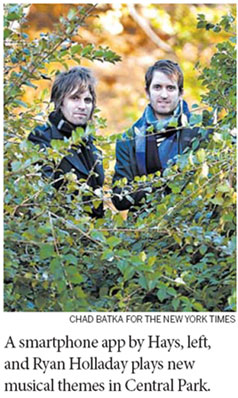App triggers tunes in a park
Updated: 2012-04-22 07:35
By James C. McKinley Jr.(The New York Times)
|
|||||||||

Clamp on headphones, start up the iPhone app by the musical duo Bluebrain and walk into Central Park. The music does not begin until you pass through an entrance and head into the trees. Then it sounds like an orchestra tuning up, a chaotic jumble of wind chimes, electronic moans and discordant strings. Walk farther into the park, and a sweet violin melody emerges over languid piano chords.
As you walk, new musical themes hit you every 20 or 30 steps, as if they were emanating from statues, playgrounds, open spaces and landmarks. At the Bethesda Fountain, in the center of the park at 72nd Street, a string quartet plays a hopeful march. A little farther east, the Kerbs Boathouse, with its tranquil pond full of model sailboats, triggers a soothing Pachelbel-like motif. Strolling across Sheep Meadow you hear a pastoral piano theme with an undercurrent of electronic arpeggios.
For Central Park the Holladays went for a classical feeling. The melodies are mostly stately, slow marches played on strings or the piano. The themes layer over one another, growing in volume as you approach certain points on the map and fading out as you move away. It's a musical Venn diagram placed over the landscape, and at any time you might have two dozen tracks playing in your ears, all meshing and colliding in surprising ways. The path you take determines what you hear with what the composers call a "location-aware album."
"It's like a choose-your-own-adventure album," said Ryan Holladay, who forms this electro-pop duo with his brother Hays.
They released the app, called Central Park (Listen to the Light), for the iPhone and iPad in the fall. The app is free, but the brothers hope the musical format will become a commercially viable medium. It uses a global positioning network to activate different themes as the listener wanders through the park. The app contains over 400 tracks. They were written to fit together harmonically like a sonic jigsaw puzzle.
"It's not just that they are using this as a novel delivery mechanism," said Peter Kirn, an electronic composer who edits the Web site Create Digital Music.
"It's part of their musical process," he said. "They are forcing you to go to a place because that place for them is musically meaningful."
The idea for the project came to the Holladay brothers more than two years ago, as they brainstormed about ways to use new applications available for the iPhone. "Wouldn't it be cool if there were an album that you would interact with in Central Park?" Hays recalled saying. "Then we started thinking about what would you be controlling, and we came to the idea of: What if it were your movement?"
Along with Bradley Feldman, a Brooklyn software developer who owns Bradley Mobile Media LLC, the brothers worked out bugs in the program as they composed their first location-aware piece of music for the National Mall in their hometown of Washington, D.C.; they released that app last spring.
Mr. Feldman wrote a new software engine for the application, borrowing ideas from video games that have different sound effects and background music tied to places in their virtual worlds. To use the program, the composers establish map coordinates for each track, and those tracks, usually loops of several minutes, are set off as the listener approaches.
"We didn't want something to sound like a machine," Mr. Feldman said. "We wanted it to sound like these guys were conducting an orchestra and watching where you are walking."
The New York Times
(China Daily 04/22/2012 page11)